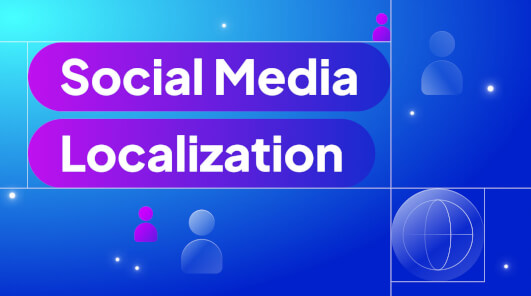The number of social media users worldwide reached 4.9 billion in 2023, and could grow to more than 5.85 billion users by 2027. With this many people consuming social media all over the world, the potential of social media for marketing has never been bigger.
But simply writing a message in your native language and expecting it to mean something to a global audience may be a bit presumptuous. That’s why many organizations are leveraging the power of social media localization to increase the engagement and conversion rates of their social media campaigns.
This article delves into essential tips and best practices for social media localization, offering insights on how to effectively adapt your content for diverse audiences.
What is social media localization?
Social media localization involves adapting social media content to suit the cultural, linguistic, and regional preferences of target audiences in a particular country, region or community. It can be highly beneficial for brands looking to make an impactful impression with diverse audiences – in fact, 72% of brand engagement happens on local web pages.
The process of localizing social posts goes beyond simply translating the language. You should also be mindful of cultural nuances, local trends, and specific audience behaviors, to ensure that the content resonates and is relevant to the local audience. When readers feel the content they’re consuming speaks directly to them, it increases engagement and the effectiveness of the campaign. In other words, by adjusting your social media presence to align with the cultural context of a target audience, it’s much easier to get your message across and inspire people to action.
Why does localization need to be an integral part of your social media?
The benefits of social media location range from increasing exposure to improving the ROI of your social media campaigns. Let’s explore some of the top reasons localization should be an integral part of your digital outreach.
Access new markets
Adopting a social media localization strategy offers a unique opportunity to tap into new markets. By adapting your content to suit the cultural and linguistic preferences of specific regions, you can break down language barriers and connect with entirely new audiences.
Nurture stronger relationships
Nearly 50% of millennials worldwide found influencers' recommendations of a brand, or product, more engaging than regular advertisements. An effort to translate social media content capitalizes on this persuasive power of social media and demonstrates a deeper appreciation of your followers. Plus, a culturally relevant experience for your global audience can help you create an enduring bond.
Enhance engagement
Adding a localization strategy to your social media marketing efforts can boost interest levels and interaction, and encourage social sharing, helping your posts go viral – or at least get more exposure. From colloquial expressions to referencing local events, a personalized approach is more likely to inspire participation. Content tailored to local languages and cultural contexts sees higher engagement rates, as users are more likely to interact with content that feels familiar and relevant.
Improved brand perception
Brands that invest in localization are perceived as more considerate and respectful of cultural differences, enhancing their image and reputation globally. Plus, it can provide competitive advantage by distinguishing your brand from competitors who may not invest in adapting their content for different markets.
Insights for Local Optimization
By engaging with local audiences, brands can gather insights and feedback specific to each region, allowing for more targeted and effective marketing strategies.
Best practices for social media localization
Here are some best practices for integrating localization into your social media strategy:
Analyze your audience: To create effectively localized content, it's important to better understand your audience by analyzing their behavior and preferences. The leading social media platforms offer analytics tools that provide insights into the demographics and interests of your followers. By using this data, you can tailor your next marketing campaign to make sure it resonates.
Be platform-specific: Consider the unique features and user behavior related to each platform across different regions. This may require adjusting posting schedules and making use of platform-specific features (such as LinkedIn InMail), as well as customizing content to align with regional preferences. Adapting to the dynamics of each platform can help enhance your visibility and engagement.
Localize hashtags: By incorporating region-specific hashtags and trending topics into your social media content plan, you can align your brand with local conversations and increase the discoverability of your content within those communities. This can help your brand resonate with local audiences by appearing current and culturally relevant.
Promote user-generated content: User-generated content is authentic and diverse, reflecting the cultural variety of your audience. By creating campaigns that invite users to share content related to your brand, products, or services, you can strengthen engagement and gain valuable insights into how your brand is perceived across different regions.
Optimize visual assets: Customizing images, graphics, and videos according to the diversity and preferences of your audience can also be highly effective. This involves using culturally appropriate visuals and showcasing scenarios that resonate with the local culture. By localizing your assets, you can enhance the overall impact of your social media localization.
Tips for finding local social media influencers
A good place to start is by researching influencers who share your brand's values and operate in the specific regions you are targeting. You can use the search functionalities of social media platforms to find influencers by relevant hashtags, keywords, and location filters.
You can also explore influencer marketing platforms (such as Traackr) that connect brands with influencers, using regional and industry filters. It's important to analyze engagement metrics, audience demographics, and the authenticity of their content before teaming up.
Great examples of social media localization
Babbel
Babbel Babbel is a German subscription-based language learning software and e-learning platform that is available in many different languages. A simple search reveals links to versions in Spanish, Greek, Italian, Arabic, German, and other languages. The company has Facebook pages tailored for various regions with posts such as the video below, which shows a Spanish-speaking person speaking Latin to a Spanish-speaking interviewer.
"Babbel uses continuous AI human translation workflows to localize our marketing for various channels, includigng, web pages, digital ads, visual assets, videos, and more."
Wunderman Thompson
Wunderman Thompson is a New York-based global marketing communications agency that operates in 90 markets with 200 offices worldwide. The company has regional-specific profiles on X (formerly known as Twitter) for the Netherlands, South Africa, Finland, and Indonesia. On each of these pages, you can find locally relevant content, such as new hires in the region or region-specific information and articles. For example, the company shared an article on its @WunThompsonIDN written by the Managing Director at Verve that appeared in PR Indonesia Magazine.
Stanley Black & Decker
Stanley Black & Decker is a leading global provider of hand tools, power tools, and related accessories, as well as security solutions and industrial products. The company operates in multiple segments, offering products for professional, industrial, and do-it-yourself users. As the company operates worldwide, it needs to promote its products in different languages. It keeps a central repository of product information and leverages advanced translation management software, complete with translation memoires and glossaries across all product teams, to render content for local consumption. Read their story.
Best platforms for social media localization
There are several platforms to choose from to execute on your social media localization strategy. Here are a handful of options to consider:
Hootsuite
With its user-friendly dashboard and network integrations for all the leading social media platforms, Hootsuite is a trusted tool for social media management. It allows users to easily schedule and plan content across different channels, while providing analytics tools that lead to a better understanding of audience demographics and engagement metrics.
Sprout Social
Sprout Social’s all-in-one social media management platform offers a wide range of features such as content scheduling, planning, and analytics. With its in-depth demographic insights, engagement metrics, and audience behavior analysis, it can provide valuable information for businesses looking to optimize their social media presence.
Buffer
Buffer is an intuitive social media scheduling and planning platform that enables seamless content management. With its analytics tools, businesses can track the performance of their posts, understand their audience's behavior, and gather insights on the success of posts. Its user-friendly interface makes it an attractive option.
Best platform to translate your social media content
As a comprehensive marketing translation solution, Smartcat is a proven tool for businesses looking to translate their social media content at scale. Here’s why:
Collaborative TMS
Smartcat's Collaborative TMS lets teams and linguists cooperate on one platform for faster translations and better communication. Built for ease and speed, the workspace enables adaptive AI and humans to sync in one centralized system of record.
AI content generation
Smartcat's use of AI contributes to faster turnaround times to match the dynamic, real-time nature of social media content. It also helps maintain a consistent brand voice and terminology across languages for a unified brand experience.
Analytics and reporting
The platform enables you to transform insights into translated content. Users can assess the effectiveness of their localization strategies, understand audience engagement in different regions and make data-driven decisions for future campaigns.
Get a personalized demo of Smartcat and discover how to harness the power of social media localization to supercharge your business.
Subscribe to our newsletter




